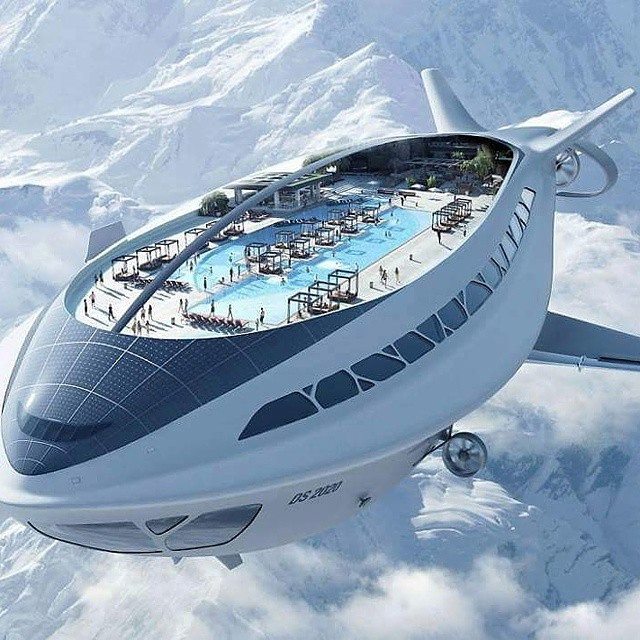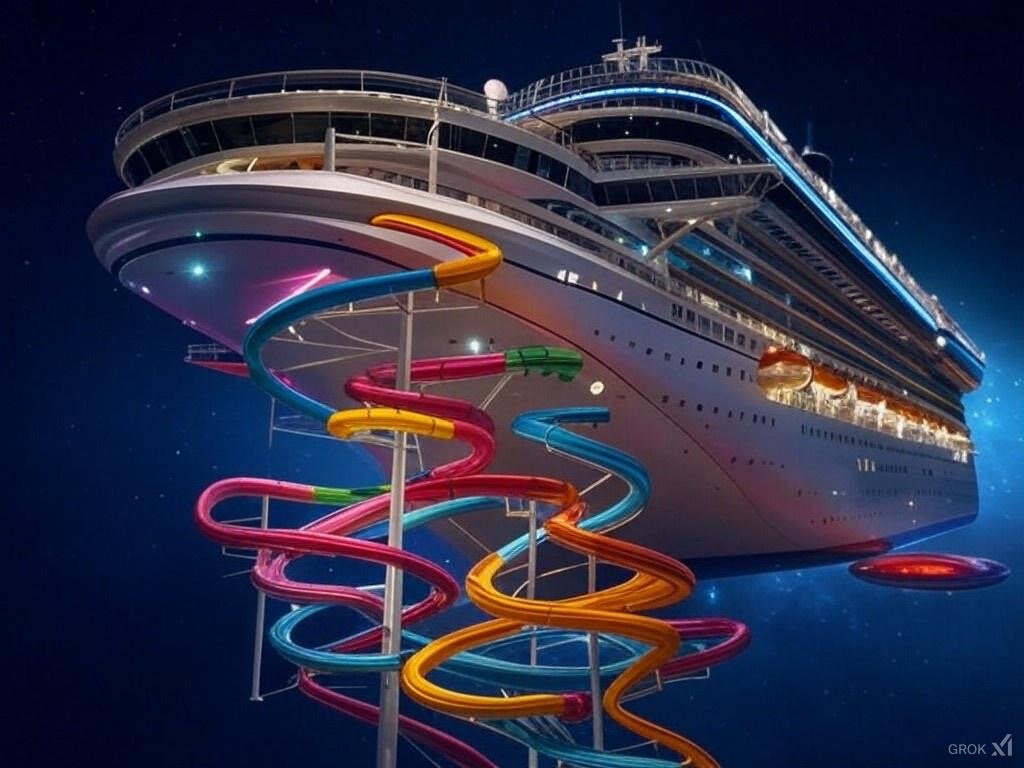The Future of Space Cruise Ships: Exploring the Next Frontier of Luxury Travel
Charting New Frontiers: Oceans, Space, and the Journey Ahead
Our thirst for exploration reaches new heights—bridging the oceans we know and the stars we dream of
Is this The Cruise Ship of The Future? Image Credit: origin unknown
As we continue to push the boundaries of exploration, the idea of space tourism is rapidly moving from science fiction to reality. While cruising the world’s oceans has long been a popular pastime, the future could see this leisurely journey extended far beyond Earth’s oceans—into the vast expanse of space. Space cruise ships, designed to carry passengers on interstellar voyages, could offer an entirely new form of luxury travel, blending the wonder of the cosmos with the comforts of modern cruising, and brand new itineraries. With advancements in space technology and ambitious projects already coming to fruition, the prospect of space cruise ships seems closer than ever. But what would it really take to transform this dream into a reality, and what kind of experiences could we expect aboard these futuristic vessels? In this article, we explore the possibilities, challenges, and excitement surrounding the evolution of space cruising, as we look to the stars for the next great frontier in luxury travel.
Cruising the Universe: What Would a Space Cruise Be Like?
There have been many versions of the space/sea hybrid in sci-fi moves, such as the Fhloston Paradise featured in Fifth Element (see above).
The space tourism industry is now planning space cruises with companies including Virgin Galactic, Boeing, SpaceX, and World View Enterprises leading the way. Entrepreneur, Elon Musk dreams of conquering space and believes it is totally doable in his lifetime.
In response, many space-ship designers are taking their inspiration from cruise ships, and no wonder. What better design could there be, but they will have a lot of work to do if they are to make their vessels anywhere near as exciting as say, Royal Caribbean’s Icon of the Seas with its multitude of attractions (although I will concede that the destination might take some beating).
AI Generated Space Cruise Ship. Image: Designed by Grok
A space cruise would offer an entirely new kind of luxury travel, where sleek spacecraft combine futuristic design with comfort and adventure. The ships themselves would be equipped with sophisticated life-support systems, offering panoramic windows for stunning views of Earth and the cosmos. Passengers would enjoy spacious cabins, gravity-simulating sections, and public areas like observation decks and high-end restaurants. With modern amenities such as spas and fitness zones adapted for zero gravity, the cruise would provide an experience unlike any other, with guests floating freely in specially designed spaces.
Attractions on a space cruise might include thrilling activities like spacewalks, allowing passengers to step into the vacuum of space and float outside the ship, as well as zero-gravity experiences inside. Stargazing from viewing decks would be a highlight, offering unparalleled views of distant stars and planets. Depending on the cruise’s itinerary, passengers could also embark on excursions to destinations like the Moon or Mars, with opportunities for guided tours and even “space mining” activities. Alongside these experiences, space cruises would offer educational talks and virtual reality exhibitions, immersing passengers in the wonders of space exploration. This combination of luxury, adventure, and discovery would make space cruising a once-in-a-lifetime journey to the stars.
The Challenges of Space Cruising: Turning Cosmic Travel into Reality
Space tourism, and more specifically space cruising, presents numerous challenges that must be addressed before it becomes a viable option for the masses. The technological hurdles are significant, with spacecraft still in development to ensure safe and comfortable travel for passengers. Spacecraft will need to counteract the effects of microgravity, provide life support, and incorporate advanced propulsion systems for efficient travel. Additionally, ensuring safety is a priority, as space travel involves risks like radiation exposure and the dangers of launch and re-entry, all of which need to be mitigated with rigorous safety protocols.
Cost is another major barrier, with current space travel prices running into millions of pounds, limiting it to the ultra-wealthy. As technology advances and operational costs decrease, space cruising could become more accessible, but the infrastructure, including spaceports and refuelling stations, must also be developed. Environmental concerns, such as the carbon emissions from rocket launches and the accumulation of space debris, must be addressed to ensure sustainable space tourism. Despite these challenges, with continued innovation and collaboration, space cruising may one day (soon) become a reality, opening up a new frontier for luxury travel.
New Horizons: When Ocean Cruises Look to the Stars
There is an unquestionable link between the sea and the skies above. From using stars for navigational purposes to star-gazing and witnessing phenomena such as the Aurora Borealis. It’s unsurprising, therefore that cruise lines look to the heavens when naming their new ships.
Luxury cruise brand Viking have named many of their ships after stars or planets, including Viking Stsr, Viking Sky, Viking Sun, Viking Jupiter, Viking Venus, Viking Mars and Viking Saturn. Viking Orion is named after the constellation Orion and also in recognition of NASA's Orion spacecraft, which was the first crewed capsule designed to carry astronauts beyond low Earth orbit. It was also the final project that the ship’s godmother, retired NASA astronaut Anna Fisher, worked on before she retired in May 2017. This ship features space-themed touches, including a NASA photo exhibit and an archway decorated with constellations leading into the Explorers’ Lounge.
Norwegian Cruise Line is launching Norwegian Luna, inspired by the relationship between the moon and ocean tides, this ship is set to debut in 2026.
The newest of Princess Cruises ships also embrace the theme with Sky Princess, Sun Princess launched last year, and Sun Princess debuting later this year.
Scenic already have a series of “Space-Ships” operating on European rivers. These vessels are designed to offer maximum space and comfort, though their “Space-Ship” designation refers to spaciousness rather than a space theme.
Want more? Cunard’s Queen Mary 2 set sail in 2019 to celebrate World Space Week on a special space-themed Transatlantic Crossing. The journey featured a variety of space-themed experiences, including talks from distinguished space explorers and astronomers.
Intergalactic Getaways - Will Space Tourism Flourish?
The future of space exploration is set to transform travel as we know it, and it’s closer than you think. For example, Orion Span’s Aurora Station set to be the world’s first luxury space hotel, is scheduled for launch in 2025. The station will accommodate up to four guests and two crew members for 12-day stays.
Guests will enjoy zero gravity, breathtaking views of Earth, and the opportunity to participate in activities like spacewalks. With its luxury cabins, dining areas, and large windows, Aurora Station promises a truly out-of-this-world experience. However, such an adventure comes at a steep price, with a stay costing approximately £7.5 million. As one of the most ambitious space tourism projects to date, it marks the beginning of a new era where space travel merges with leisure, offering a glimpse into the future of cosmic cruising.Frank Bunger, founder and CEO of Orion Span, said in an interview that his planned orbital hotel will be “like a small cruise ship”. Apparently at least 26 people have already paid the $80,000 deposit to reserve their stay - I wonder if that includes a drinks package?
The concept of “space cruise ships” is epitomised in the form of SpaceX’s Starship. Designed by Elon Musk’s company, Starship is a fully reusable spacecraft capable of transporting both humans and cargo to destinations such as the Moon, Mars, and beyond. With a sleek stainless-steel design, a towering height of 120 metres, and the ability to carry up to 100 passengers, Starship is not just a vessel for interplanetary exploration but a potential precursor to space tourism on an unprecedented scale.
Starship’s development is progressing rapidly, with multiple test flights already conducted and ambitious missions on the horizon. SpaceX envisions its spacecraft revolutionising travel with lunar flybys, uncrewed Mars missions, and even Earth-to-Earth suborbital flights that could make global travel as fast as a few hours. Collaborations with NASA, such as its role as the Human Landing System for the Artemis lunar missions, highlight its versatility. While these advancements are rooted in exploration, they hint at a future where “space cruising” becomes a reality, offering experiences that blend adventure, luxury, and the ultimate frontier: the cosmos.
Space-themed Cruises Back on Earth
If this article has ignited a passion for space travel, here are a few cruise options that might bridge the gap until the dream becomes a reality.
Star Trek: The Cruise
An immersive 7-day voyage on Royal Caribbean’s Explorer of the Seas, where fans can engage with Star Trek stars and participate in themed events. The upcoming cruise is scheduled from February 23 to March 2, 2025.
Havila Voyages’ Astronomy Cruises.
These cruises, departing in March and October, are designed for stargazing enthusiasts, offering prime opportunities to observe celestial phenomena.
Hurtigruten Astronomy Voyage
This 12-day cruise includes lectures and a guided tour of the night sky. Renowned astronomers will lead the voyages, which include dates in 2025 and 2026.
Virgin Voyages’ Solar Eclipse Cruises 2026
In August 2026, Virgin Voyages offers adults-only cruises designed to sail directly into the path of totality for a solar eclipse. These 12 to 15-night voyages include stops in destinations such as Dublin, Glasgow, and Reykjavik aboard the Valiant Lady, as well as the Amalfi Coast, Mallorca, and Cannes on the Scarlet Lady.
Carnival Cruise Line’s Space Cruisers™
A program for children aged 2–11, introducing them to space exploration through NASA-inspired activities at Camp Ocean. In addition to themed cruises, several ships have space-related names or connections:
These offerings provide a range of space-themed experiences for enthusiasts, from immersive voyages to educational programs for young explorers.
~~~~~~~~~~~~~~~~~~~~~~~~~



